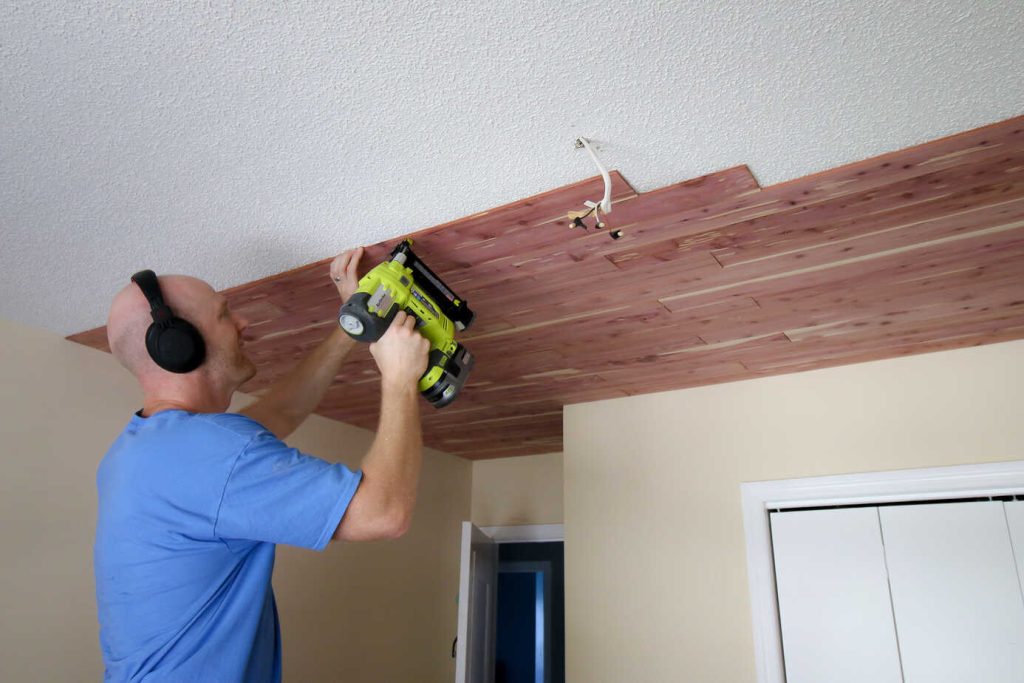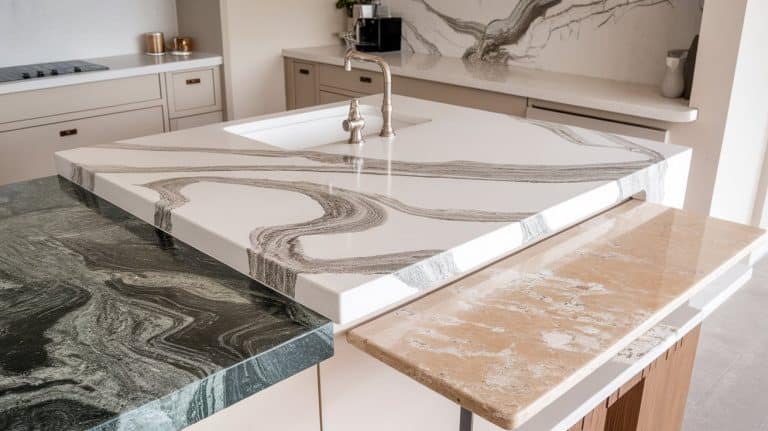A Complete Guide on Tongue and Groove Ceiling & Its Costs
Are you tired of staring at plain, boring ceilings? Well, look no further because we are about to introduce you to the tongue and groove ceiling! Think about a puzzle where each piece fits perfectly; that’s the idea behind this type of ceiling. It’s made up of individual wooden boards with special edges.
However, the cost can depend on factors like the type of wood you choose and the size of your ceiling. You can get the reactions of your friends and family when they come into your home and see that stunning tongue-and-groove ceiling. It puts a lot of grace and fashion! And who knows, maybe you’ll even impress your neighbors enough for them to invite you over to see their ceilings.
So, if you’re ready to turn your ceiling into a work of art, try the tongue and groove option. It may cost a bit, but the results are worth it.
Get ready to look up and say, “Ceiling, you’ve never looked so good!”
What is Tongue and Groove Ceiling?

A tongue and groove ceiling is a type of ceiling installation using interlocking planks. The planks have a ridge (tongue) on one side and a groove on the other. They fit together snugly, creating a seamless and secure connection. This method provides a visually appealing and uniform surface. It also prevents shifting or separation over time, ensuring durability.
Tongue and groove ceilings are available in various materials like wood or PVC. They can be installed by professionals or as a DIY project. Simply align the edges, slide them together, and secure them in place. These ceilings add elegance to any space and can be customized with stains or paint. They suit different architectural styles and offer an easy and efficient way to enhance the aesthetics of a room.
Factors Impacting Cost of Tongue and Groove

Tongue and groove ceilings are a popular choice for covered entrances and other areas where a pleasant, authentic look is required. These ceilings contain flat boards, with one side having a larger tongue and the other side having a receiving groove. The tongue and groove run along all four sides of each board, allowing them to fit together trouble-free. Fitting a tongue and groove ceiling is a simple DIY project that requires minimal sticking or nailing. When it comes to finishing options, tongue and groove ceilings can be left natural, blackened, or painted, depending on which radiant you want. Each option offers a different look and feel. For example, staining the ceiling with a darker stain can create a solid look when paired with matching flooring.
2. Installation Process
Before installing a tongue and groove ceiling, it is essential to prepare the surface by ensuring it is clean, dry, and level. Any existing ceiling materials waste material should be removed to create a smooth base for the new installing process. It starts with securing the first board along one wall or the longest unbroken edge. This board should be aligned and leveled accurately, as it serves as the reference point for the entire ceiling installation. Alter boards are fit by inserting the groove of each board onto the tongue of the previous one. This process is repeated until the entire ceiling is covered. Change should be taken to maintain spacing and alignment to achieve a pleasing result.
3. Visible Attraction
Tongue and groove ceilings give off an aura of classic grace that easily increase the pleasing attraction in any space. The smooth, solid surface created by the interlocking board gives a feel of gracefulness and architectural detail, upgrading the attraction of the room to new heights. The tongue and groove design, characterized by the smooth and exact fitting of the board, creates an attractive effect that draws attention and gives the ceiling a touch of volume and dimension. The carefully crafted interlocking mechanism not only adds visible interest but also ensures organized fairness, resulting in a ceiling that gives a feeling of craftsmanship.
4. Type of Wood
Tongue and groove ceilings can be constructed using various types of wood, including cedar, pine, oak, and cypress. Each wood species offers unique characteristics in terms of color, grain pattern, and durability, allowing homeowners to choose a material that best suits their preferences and budget.
5. Durability
Tongue and groove ceilings are highly considered for their outstanding durability, making them an excellent long-term investment. The original interlocking mechanism between the board is a solid and secure connection, resulting in a strong structure. This innovative design ensures that the ceiling remains completely perfect, even in the face of constant usage and the effects of time. The interlocking system prevents any weak points or twists, allowing the ceiling to maintain its perfect appearance for years to come. With their basic stability, tongue and groove ceilings are specifically engineered to withstand everyday wear and tear, making them a reliable choice that will go through for generations.
6. Noise Reduction
The solid construction of tongue and groove ceilings offers outstanding noise reduction capabilities, making them a terrific choice for environments where maintaining peace and calmness is more important. The tongue and groove design, with its interlocking board, creates a simple and tight fit that acts as a highly effective natural barrier against sound transmission. This design feature allows the ceiling to easily absorb and quiet sound waves that might otherwise pass through floors or rooms. By the worth of their tightly interlocking planks, tongue and groove ceilings significantly reduce noise transmission, resulting in a quieter and more clear environment. The interlocking mechanism ensures that even the smallest gaps are minimized, preventing sound leakage and creating a soundproofing effect.
7. Size of The Space
The size of the space where you plan to fit the tongue and groove ceiling is a key factor that also impacts the total cost of the project. When dealing with larger areas, you will require a large number of materials, which can affect increase the overall expenses. Therefore, it becomes required to carefully measure the dimensions of the ceiling to rate the amount of material needed accurately. Moreover, a larger space typically needs more detailed installation processes and a long duration of labor. As the area expands, the problem of fitting the tongue and groove ceiling may increase due to the need for additional support structures to fit in with the larger expanse.
8. Material Cost
The choice of wood or other materials impacts the overall cost of your tongue and groove ceiling. The selection of different materials comes with varying price ranges and qualities, allowing you to find an option that suits your budget and requirements. Softwoods, like pine, are generally more affordable, making them a popular choice for budget-friendly individuals. Even with their lower cost, softwoods still provide excellent durability and can withstand everyday wear. On the other hand, hardwoods, such as timber, are pricier but offer a luxurious grace and long life usage. These high-quality materials give style to your space and can last for generations.
9. Installation Labor
When calculating the expenses associated with positioning a tongue and groove ceiling, one must take into account the outstanding contribution of hiring a skilled professional contractor or carpenter. Giving the task to an experienced individual ensures that the setup is accurate with precision and guarantees a superior result. The labor cost involved in this process can improve various factors, including the difficulty of fitting. Where the ceiling includes curves, angles, or fancy designs, the arrangement method becomes more time-consuming. Hence, the labor expenses in such scenarios are likely to be higher due to the additional effort and expertise required to navigate these twists successfully.
10. Additional Expenses
In addition to the primary costs, there are multi additional expenses that should be taken into account when planning a tongue and groove ceiling project. These expenses surround a range of factors that contribute to the cost and complexity of the insert process. Firstly, preparing the surface for the installation of the tongue and groove ceiling requires careful attention and may involve additional expenses. If there is an existing ceiling in place, it may need to be removed before the new ceiling can sit in place. This process typically involves labor costs to remove the old ceiling materials. Additionally, any repairs or modifications needed to the basic structures, such as support, might be necessary to ensure stability and proper support for the new ceiling.
Due to the different factors involved, it is challenging to provide an exact cost without specific details about the project. It is recommended to consult with local contractors or suppliers who can provide an evaluation based on your specific requirements and location. Obtaining multiple thoughts will help you get a better idea of the possible costs involved in your particular situation.
Cost to Get a Tongue and Groove Ceiling

Adding a tongue and groove ceiling can bring timeless elegance to your space. Here’s a breakdown of the estimated cost involved:
- Room Size: For a 150-square-foot room, the overall expense typically ranges between $1,550 and $1,800. Keep in mind that this cost may vary depending on your room’s dimensions.
- Hiring a Professional: If you decide to hire a professional for the job, the average cost, including both materials and labor, is around $5 to $8 per square foot. This option provides you with expertise and ensures a high-quality installation.
- DIY Approach: Opting for a do-it-yourself (DIY) installation can be more budget-friendly. The average expense is expected to be approximately $4 to $5 per square foot. However, remember that this means you’ll have to handle the installation yourself.
- Material Costs: The type of wood you choose for your tongue and groove ceiling will affect the overall cost. Pine designs are generally more affordable, ranging from $3 to $5 per square foot. If you prefer alternative wood species, prices can vary between $2 to $9 per square foot.
- Labor Fees: Whether you hire a professional or undertake the project yourself, labor fees play a significant role. If you hire someone, labor costs typically range from $1 to $4 per square foot, depending on the complexity of the installation.
- DIY Savings: If you opt for the DIY approach, you can save approximately $1 to $4 per square foot on labor costs. This can be a significant cost-saving factor if you’re comfortable handling the installation on your own.
- Additional Expenses: Regardless of whether you hire a professional or take the DIY route, you’ll need to factor in the cost of necessary materials and equipment. Items such as a stud finder, tape measure, miter saw, nails, jigsaw, ladder, and nail gun are essential for a successful installation.
- Hiring a Ceiling Contractor: If you prefer to leave the job to the experts, hiring a ceiling contractor can be a convenient option. However, this convenience comes at a higher cost, ranging from $5 to $12 per square foot.
Remember, the final cost may vary based on your location, specific room requirements, and the prevailing rates in different cities. Proper planning and understanding of these cost factors will help you achieve a stunning tongue and groove ceiling without any financial surprises.
Conclusion
All in all, we’ve found the fascinating tongue and groove ceilings. Well, a tongue and groove ceiling is a skillful architectural feature that adds beauty to any space. It’s like the peanut butter and jelly of ceilings – they fit together, creating a polished look that’ll impress your guests.
It’s not much pricey; The cost depends on various factors, such as the type of wood you choose and the size of your ceiling. If you’re feeling fancy and want to brighten up your ceiling, you can use hardwoods like timber or mahogany. On the other hand, if you’re budget-conscious and still want a stylish ceiling, softer woods like pine or cedar can save you some money.
If you’re feeling thoughtless and have some DIY skills, then why not try to show up your skills? Just make sure you don’t end up with a ceiling that is like a modern art masterpiece gone wrong.
Frequently Asked Questions
Can a Tongue and Groove Ceiling be Installed in Outdoor Areas?
Yes, tongue and groove ceilings can be set in outdoor areas like covered entrances, terraces, or shelters. However, it is important to use materials that are suitable for exterior applications and can withstand weather conditions.
Can I Install a Tongue and Groove Ceiling myself, or Do I Need to Hire a Professional?
While it is possible to install a tongue and groove ceiling yourself if you have the necessary skills and tools, it is generally recommended to hire a professional for an accurate and high-quality installation. Professionals have the expertise to ensure proper fitting and can handle any challenges that may arise during the process.
How Do I Maintain a Tongue and Groove Ceiling?
Maintaining a tongue and groove ceiling typically involves regular cleaning and occasional refinishing or resealing, depending on the type of material used. Dusting or vacuuming the ceiling periodically and wiping it down with a damp cloth can help keep it clean. Following the manufacturer’s guidelines for maintenance and avoiding excessive moisture exposure is also essential.
Can a Tongue and Groove Ceiling be Used to Cover Existing Popcorn or Textured Ceilings?
Yes, a tongue and groove ceiling can be used to cover existing popcorn or textured ceilings. It provides a smooth and attractive alternative to outdated or damaged ceilings and usefully conceals any imperfections. However, it’s important to evaluate the structural unity of the existing ceiling and make any necessary repairs before fixing the tongue and groove boards.







